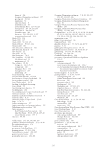19 2 Water – where, when, how much? Challenges in understanding and managing flow in rivers of the Lake Eyre Basin Justin Costelloe Introduction The floods and zero flow periods of the unregulated rivers of the Lake Eyre Basin drive spectacular booms and busts in ecosystem responses (Kingsford et al. 1999 Puckridge et al. 2000). In addition to their renowned environmental value, the rivers are central to the economy of the arid zone, sustaining pastoralism (see Chapters 10 and 11) and tourism (see Chapter 13), and their flow patterns affect the infrastructure of important energy industries (oil, gas and geothermal). While the rivers are unregulated and currently experience only minor water resource use (see Chapter 20), they are experiencing constantly changing pressures on land use and increasing demands on water resources, particularly from expanding energy industries (Kingsford et al. 2014 see Chapter 19). Arid zone river systems are significantly challenging for describing the basics of flow – where, when and how much? Traditionally, hydrological analysis occurs when there is either a potential for substantially changing the river for human use, such as building a dam, or for managing a river where there are already significant diversions for human use. It could be argued that detailed observations of flows and construction of complex hydrological models are not warranted for Lake Eyre Basin rivers, but this ignores the ever-present management challenges. Natural resource managers need to be able to identify changes in the flow regime of these rivers from stressors, including water extraction, floodplain modifications and climate change. Hydrological models are essential for estimating how proposed changes may affect the rivers and their biota. Therefore, monitoring of flows and flooding patterns in these rivers is not an academic exercise – both are central to the sustainable management of Lake Eyre Basin rivers. Current state of monitoring One of the major challenges for the management of the water resources of the Lake Eyre Basin is the paucity of conventional hydrological data. The Lake Eyre Basin is a similar size to the Murray–Darling Basin, both just over 1 million km2, but there are only 13 gauging stations (Fig. 2.1) in the Lake Eyre Basin, with records of more than 15 years of data compared to more than 160 gauges in the Murray–Darling Basin (Kennard et al. 2010). The number of gauging stations shrank in the 1990s in the Lake Eyre Basin (see Table 2.1), but there has been a recent resurgence due to increased investment by the Bureau of Meteorology and the Queensland and South Australian governments, and some industry monitoring (e.g. Santos
Downloaded from CSIRO with access from at 216.73.216.176 on Nov 27, 2025, 5:07 AM. (c) CSIRO Publishing

















































































































































































































































































